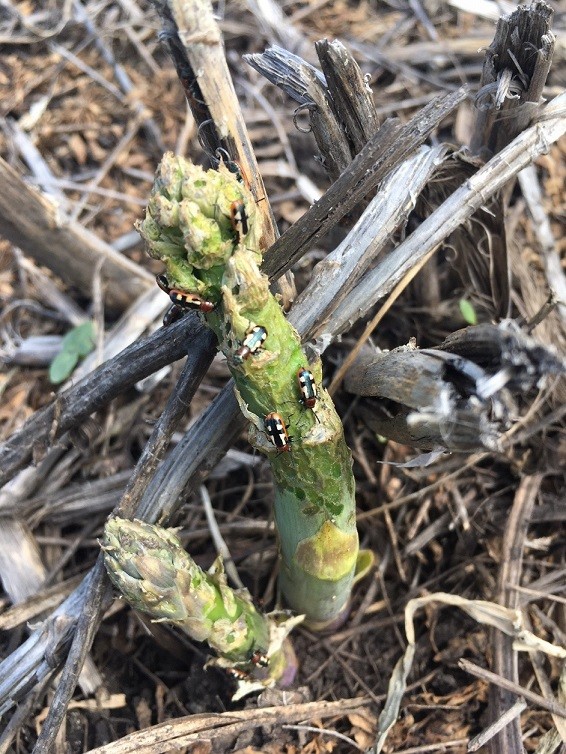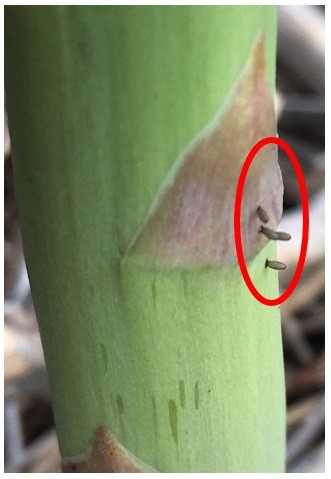Common Asparagus Beetle Management During Harvest Season
Ethan Grundberg, Vegetable Specialist
Eastern New York Commercial Horticulture
The beginning stages of Common asparagus beetle (Crioceris asparagiI) infestations often go unnoticed. Since the beetles have two to three generations per year (depending upon where you are in our region), the population can build quickly over the course of a couple of years and catch growers off-guard at harvest.
Overwintered adults emerge from their pupae about the same time that asparagus spears begin to push. They quickly begin to feed on the tender shoots causing a sort of rasping damage that browns quickly in the field or post-harvest. The beetles then mate and deposit their eggs in vertical lines along the spears as shown in the image. After about a week, those eggs hatch into small grubs that continue to feed on spears before pupating in the soil.
Though the larvae, not adults, are most susceptible to insecticides, growers experiencing significant early damage (the economic threshold is suggested to be when 5%-10% of spears have adults present) may need to use an insecticide to knock down the adults before targeting larvae and later generations on ferns. Given the need to continue harvesting every 1-2 days (a practice that also helps remove eggs from the field to slow the population growth), a short Pre-Harvest Interval (PHI) and Restricted Entry Interval (REI) are key to selecting an appropriate labeled insecticide.
The standard insecticide options are pyrethroids (IRAC Group 3A), such as Pounce 25 WP and other labeled permethrin formulations (1 day PHI, 12 hour REI) or PyGanic 5.0 (OMRI, 0 day PHI, 12 hour REI). Some neonicitnoids (IRAC Group 4A), such as Assail 70 WP and Anarchy 30 SG (both acetamiprid), are also labeled for asparagus beetle adults and larvae during harvest (1 day PHI, 12 hour REI). Lannate (methomyl, IRAC Group 1A), is also options if you are willing to equip the harvest crew with early entry PPE (1 day PHI, 48 hour REI) to continue removing egg masses on cut spears. An easier option for those looking to use an organophosphate is Sevin XLR Plus (carbaryl, 1 day PHI, 12 hour REI). Note that Lorsban (chlorpyrifos) is sometimes recommended in other states, but IS NOT allowed for use on asparagus in New York.
For heavily infested fields, continue scouting the asparagus after harvest and target second and/or third generations with any of the options listed above or with IRAC Group 5 spinosyns, such as Radiant or Entrust (OMRI), both of which have a 60 day PHI. Cleaning fields of old stalks after mowing in the fall can also help reduce the overwintering populations.
 1. Common asparagus beetle adults feeding on an emerging spear
1. Common asparagus beetle adults feeding on an emerging spear 2. Grayish colored asparagus beetle eggs visible in a vertical line on a young spear
2. Grayish colored asparagus beetle eggs visible in a vertical line on a young spear
Upcoming Events
Ag Labor Road Show IX
December 1, 2025 : Save the Date! - Ag Labor Roadshow Webinar 1
In addition to the in-person Ag Labor Roadshow program in our region on December 9, two webinars are scheduled for December 1 and December 22. Each webinar will focus on different program content that is different from the in-person sessions. These webinars are an added benefit to program registration.
December 9, 2025 : Save the Date - Ag Labor Road Show In-Person Event (Greenwich, NY)
Greenwich, NY
The Roadshow delivers essential updates on labor law, regulations, and workforce best practices—tailored for farm owners, managers, and ag service providers. Sessions also focus on practical strategies to boost communication, strengthen retention, and build a positive workplace culture.
The in-person session for Eastern NY is December 9 - Elks Lodge, Greenwich, NY - full day in person session
Additional in-person sessions are:
December 10 - Hilton Garden Inn, Watertown, NY, December 17 - Cornell AgriTech, Geneva, NY, December 18 - Genesee Community College, Batavia, NY
December 22, 2025 : Save the Date! - Ag Labor Roadshow Webinar 2
In addition to the in-person Ag Labor Roadshow program in our region on December 9, two webinars are scheduled for December 1 and December 22. Each webinar will focus on different program content that is different from the in-person sessions. These webinars are an added benefit to program registration.
How to Obtain a Pesticide Applicator License
December 17, 2025
Thinking about becoming a certified pesticide applicator in New York, but aren't sure where to start? Join DEC representative Kenneth Klubek for a discussion on who needs to become a certified pesticide applicator, certification types, examination procedures, and recertification. Participants will have ample opportunity to ask questions during the program.
2026 Winter Cut Flower Webinar Series
January 6, 2026 : Session 1: Cut Flower Cost Calculator Updates and Woody Cuts
Session 1: Cut Flower Cost Calculator Updates and Woody Cuts
January 13, 2026 : Session 2: Perennials and Industry Trends
Session 2: Perennials and Industry Trends
January 20, 2026 : Session 3: Anaerobic Soil Disinfestation and Biochar
Session 3: Anaerobic Soil Disinfestation and Biochar
January 27, 2026 : Session 4: Beneficial Insects and Propagation Techniques
Session 4: Beneficial Insects and Propagation Techniques
February 3, 2026 : Session 5: Fungal and Insect Pests and Market Trends
Session 5: Fungal and Insect Pests and Market Trends












































